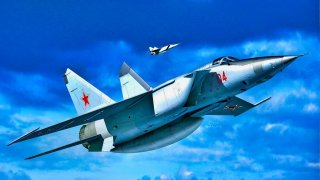Russia's MiG-25 Foxbat Fighter Made the U.S. Air Force 'Freak'
The MiG-25 "Foxbat," developed by the Soviet Union's Mikoyan-Gurevich design bureau in response to U.S. U-2 and SR-71 reconnaissance planes, became one of the fastest interceptors ever built.
Summary and 4 Points You Need to Know: The MiG-25 "Foxbat," developed by the Soviet Union's Mikoyan-Gurevich design bureau in response to U.S. U-2 and SR-71 reconnaissance planes, became one of the fastest interceptors ever built.
-Capable of speeds up to Mach 2.83 and designed for high-altitude operations, the Foxbat featured a stainless-steel body and powerful Tumansky turbojet engines.
-Despite its impressive specs, the aircraft had significant limitations, including a short combat radius and poor maneuverability at lower altitudes.
-Initially alarming Western intelligence, the MiG-25's reputation diminished after a 1976 defection revealed its vulnerabilities, influencing the design of the F-15 Eagle.
The MiG-25 Foxbat Freaked Out American Intelligence Analysts
The Mikoyan-Gurevich design bureau was one of the most important Soviet producers of military equipment throughout the Cold War. Their aircraft are still in use today.
The Specs
One of the bureau’s iconic aircraft was the MiG-25 “Foxbat.” This bird was conceived in the late 1950s as a response to the U-2 spy plane. Moscow was fed up with constant U-2 overflights, so they developed one of the fastest interceptor aircraft in history – and the second-fastest serially produced aircraft after America’s SR-71 Blackbird.
These birds had to be fast and nimble to chase down the U-2 and the SR-71. They also had to be able to operate at high altitudes, since those aircraft certainly could.
To better withstand the stresses of high-altitude, high-speed flight, the Foxbat had a stainless-steel body. This meant the bird could take the heat generated by traveling at Mach 2.83. But the use of stainless steel also meant the bird was exceptionally heavy, causing it to be a gas guzzler and increasing the cost of operating the machine.
Two Tumansky R-15B-300 afterburning turbojets, specifically designed for high-altitude performance, were chosen to power the MiG-25.
Mikoyan-Gurevich equipped the MiG-25 with radar systems that could identify targets from long range. They further armed the bird with R-4 air-to-air missiles. When this plane was used for reconnaissance, however, Mikoyan-Gurevich designed it to be stripped of the bulk of its combat capacity so that cameras could be mounted, along with cumbersome electronic surveillance equipment.
Thus, just as its American U-2 and SR-71 rivals were designed to do, the MiG-25 was made to penetrate deep inside enemy territory and conduct intensive surveillance mission sets.
The MiG-25 Foxbat sounds great, right?
The Foxbat: Not Great, Not Terrible
While it did break some records, and it scared the bejesus out of Western intelligence services when it made its debut, the bird had a lot of problems.
As stated above, the stainless-steel airframe made the MiG-25 a gas hog.
That also meant the bird had a very limited combat radius. Speed was its mainstay, not stealth. The frame made the bird bulky and easier to spot on radar, and the MiG-25 was nowhere near as graceful or maneuverable at lower altitudes and slower speeds.
Nevertheless, the West freaked when it first heard about the MiG-25. What became known as the “Foxbat Scare” broke out. America was so worried about what the MiG-25 could do, that these fears heavily influenced the design and development of the F-15 Eagle.
These fears subsided in 1976, when Soviet pilot Viktor Belenko defected to Japan by flying his MiG-25 Foxbat there. The Americans interceded and took possession of the Foxbat.
After studying it in detail, the Americans quickly figured out that this bird had many limitations, and that Western technology could outpace the MiG-25.
The Soviet MiG-25 Foxbat saw combat throughout the world over its lifespan. It fought in the gruesome Iran-Iraq War. The Soviet air force used the MiG-25 for recon missions during its botched war in Afghanistan. But the warplane never lived up to the promises Mikoyan-Gurevich made.
Author Experience and Expertise: Brandon J. Weichert
Brandon J. Weichert, a National Interest national security analyst, is a former Congressional staffer and geopolitical analyst who is a contributor at The Washington Times, the Asia Times, and The-Pipeline. He is the author of Winning Space: How America Remains a Superpower, Biohacked: China’s Race to Control Life, and The Shadow War: Iran’s Quest for Supremacy. His next book, A Disaster of Our Own Making: How the West Lost Ukraine, is due October 22 from Encounter Books. Weichert can be followed via Twitter @WeTheBrandon.
All images are Creative Commons or Shutterstock.
From the Vault
Russia Freaked Out: Why the U.S. Navy 'Unretired' the Iowa-Class Battleships
Battleship vs. Battlecruiser: Iowa-Class vs. Russia's Kirov-Class (Who Wins?)


